“[German] is the only language that can get to the center of this…and not simply because it is my mother tongue, or that it could restore to us the lost ability to speak of God, for since Auschwitz God has departed the realm of human experience. And a return would have to come from the idiom of death itself…Given the gas chamber, no articles of faith or consolation are valid anymore, to say nothing of literature.”
 Author Dieter Schlesak was only ten years old when the Russians invaded his town of Sighisoara in German Transylvania (now Rumania) in August 1944, and he has been struggling to understand the Holocaust and how it happened ever since. He had tried to write a novel about it once before, he says in a statement written in February, 2011, but he “threw 450 pages of an ‘author’s text’ into the wastebasket, because I, as an author, have absolutely no mandate, and could never, even stylistically or linguistically, approach such horror, which [the poet] Adorno had already announced in his [own] verdict on Auschwitz.” Adorno had famously stated in 1949 that “After Auschwitz, poetry is no longer possible.”
Author Dieter Schlesak was only ten years old when the Russians invaded his town of Sighisoara in German Transylvania (now Rumania) in August 1944, and he has been struggling to understand the Holocaust and how it happened ever since. He had tried to write a novel about it once before, he says in a statement written in February, 2011, but he “threw 450 pages of an ‘author’s text’ into the wastebasket, because I, as an author, have absolutely no mandate, and could never, even stylistically or linguistically, approach such horror, which [the poet] Adorno had already announced in his [own] verdict on Auschwitz.” Adorno had famously stated in 1949 that “After Auschwitz, poetry is no longer possible.”

Schlesak, however, succeeds in creating a monumental analysis of Auschwitz, almost paralyzing in the completeness of its horror on every possible level, by using a “collective narrator,” a character he calls “Adam Salmen.” Adam as narrator is a Sondercommando of the Jewish “Special Action Squad” under the Germans, a man whose agonizing job it is to report on the deaths in the gas chambers and the tallies of the cremation ovens. On his own time, however, he keeps notes in tiny handwriting on equally tiny scrolls which he hides as a permanent record of what he has seen, as did several real survivors of Auschwitz, whose diaries the author uses in creating the character of Adam.
The Nazi point of view is represented primarily by Viktor Capesius, formerly a pharmacist in Sighisoara, someone author Schlesak knew personally and with whom he had many interviews after the war. (Capesius had once courted Schlesak’s mother.) Members of his own family were also sources—especially Roland Albert, his mother’s favorite brother, who joined the SS and achieved the rank of lieutenant, working as a guard at Auschwitz. The narrator’s psychic agony at what he sees happening but cannot prevent, contrasts vividly with the commitment to the horror and (later) the attempts to justify their behavior by people the author knew from civilian life, highlighting the levels on which Hitler and the Nazis manipulated their followers, some of them all too willing to become part of a group in which they might achieve high prestige and rank. Some, like Capesius, also enriched themselves by stealing from the people they were murdering.
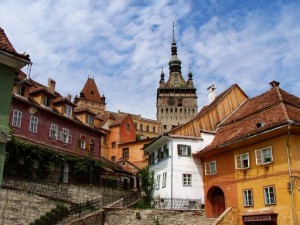 The transcripts from several trials are used for background and detail here. The Nuremberg Trials of 1945 and 1946, tried twenty-four of the biggest criminals, with many other lesser-ranked officials who were witnesses in that trial turned over to Poland for later prosecution in 1947. That trial, called the First Auschwitz Trial, resulted in many more convictions. A third trial, in Frankfurt from December, 1963 – August, 1965, convicted even more of the lesser officials, including many of the people mentioned in this book. It is the conflicting testimony from the Frankfurt trials, provided by SS guards, administrators, and camp survivors, on which the author draws for much of his detail here—creating a fascinating portrait of some of the monsters of Auschwitz as they try to save their own lives and reputations fully twenty years after the war. The author’s own
The transcripts from several trials are used for background and detail here. The Nuremberg Trials of 1945 and 1946, tried twenty-four of the biggest criminals, with many other lesser-ranked officials who were witnesses in that trial turned over to Poland for later prosecution in 1947. That trial, called the First Auschwitz Trial, resulted in many more convictions. A third trial, in Frankfurt from December, 1963 – August, 1965, convicted even more of the lesser officials, including many of the people mentioned in this book. It is the conflicting testimony from the Frankfurt trials, provided by SS guards, administrators, and camp survivors, on which the author draws for much of his detail here—creating a fascinating portrait of some of the monsters of Auschwitz as they try to save their own lives and reputations fully twenty years after the war. The author’s own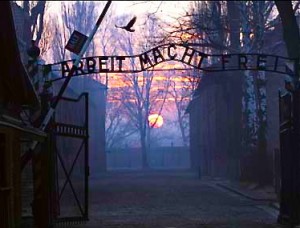 commentary about how so many people seem to have come to believe that they really did not have a choice and therefore were innocent gets into the psychology of power, with some of these officers and administrators testifying (and seeming to really believe) that they were not present for events in which they were clearly present, some of them trying to doctor the records before the trial, and others manufacturing alibis through innocent friends with whom they had contact in the twenty years since the war.
commentary about how so many people seem to have come to believe that they really did not have a choice and therefore were innocent gets into the psychology of power, with some of these officers and administrators testifying (and seeming to really believe) that they were not present for events in which they were clearly present, some of them trying to doctor the records before the trial, and others manufacturing alibis through innocent friends with whom they had contact in the twenty years since the war.
Photos, and much of Adam’s commentary, reflect the human side of the Holocaust, smaller pictures of real people performing real actions, rather than the overwhelming horrors of mass graves. Because Adam is based in part on the Jewish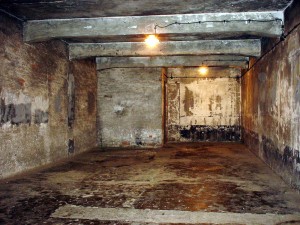 friends the author knew in Sighisoara, along with the few survivors he was able to interview much later, the character of Adam is far more comprehensive (and sometimes contradictory) than the typical narrator would be. Though he gives the numbers of deaths per day, week, month, and year, the sheer size of these totals is overwhelming, and the little details become even more memorable. As the war comes to an end, the deaths of Hungarian Jews at Auschwitz increase, on the orders of Adolf Eichmann and two of his accomplices. SS guards and officers, suddenly worried that their own subordinates will testify against them for what they have done as the war winds down, plan the executions of their own men to save themselves.
friends the author knew in Sighisoara, along with the few survivors he was able to interview much later, the character of Adam is far more comprehensive (and sometimes contradictory) than the typical narrator would be. Though he gives the numbers of deaths per day, week, month, and year, the sheer size of these totals is overwhelming, and the little details become even more memorable. As the war comes to an end, the deaths of Hungarian Jews at Auschwitz increase, on the orders of Adolf Eichmann and two of his accomplices. SS guards and officers, suddenly worried that their own subordinates will testify against them for what they have done as the war winds down, plan the executions of their own men to save themselves.
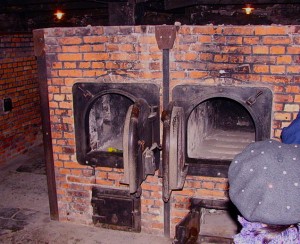
This is a difficult book to read—the horrors are so great and so overwhelming—but Schlesak does not waver in his determination to find out exactly what happened and how. The novel moves around, changing speakers, introducing and discussing an event from the point of view of one person at one point, then later in the book, giving a somewhat different point of view on the same event by a different person. An Afterword gives the biographies and ultimate fates of the characters mentioned in this book. This “documentary novel,” which includes much real trial testimony and many written sources, may not provide information that scholars could not get elsewhere, but the author’s own concerns as a German speaker who, for more than seventy years has tried and often failed to come to grips with the Holocaust, are worthy of respect.
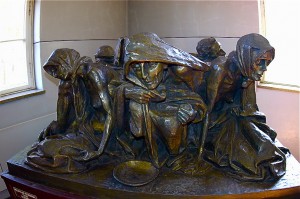
Ultimately, Schlesak has succeeded in writing about Auschwitz, something he and the poet Theodor Adorno found impossible to do before now, but he required a composite narrator and a lifetime of work to cope with the scale of the horrors.
Photos, in order:
The author’s photo is from http://www.evz.ro
Sighisoara, now part of Rumania, is in the center of the country. http://anghel.exofire.net
The entrance to Auschwitz with its slogan, “Work Will Make You Free,” is shown here: http://news.bbc.co.uk
The gas chamber: http://ml3167.k12.sd.us
The crematorium: http://everybo.dy.fi
The Auschwitz statue: http://www.lindervideo.com
A video showing photos of the Auschwitz Museum, as it now looks, alternating with old photos from the war, may be seen here. http://www.youtube.com/watch?
